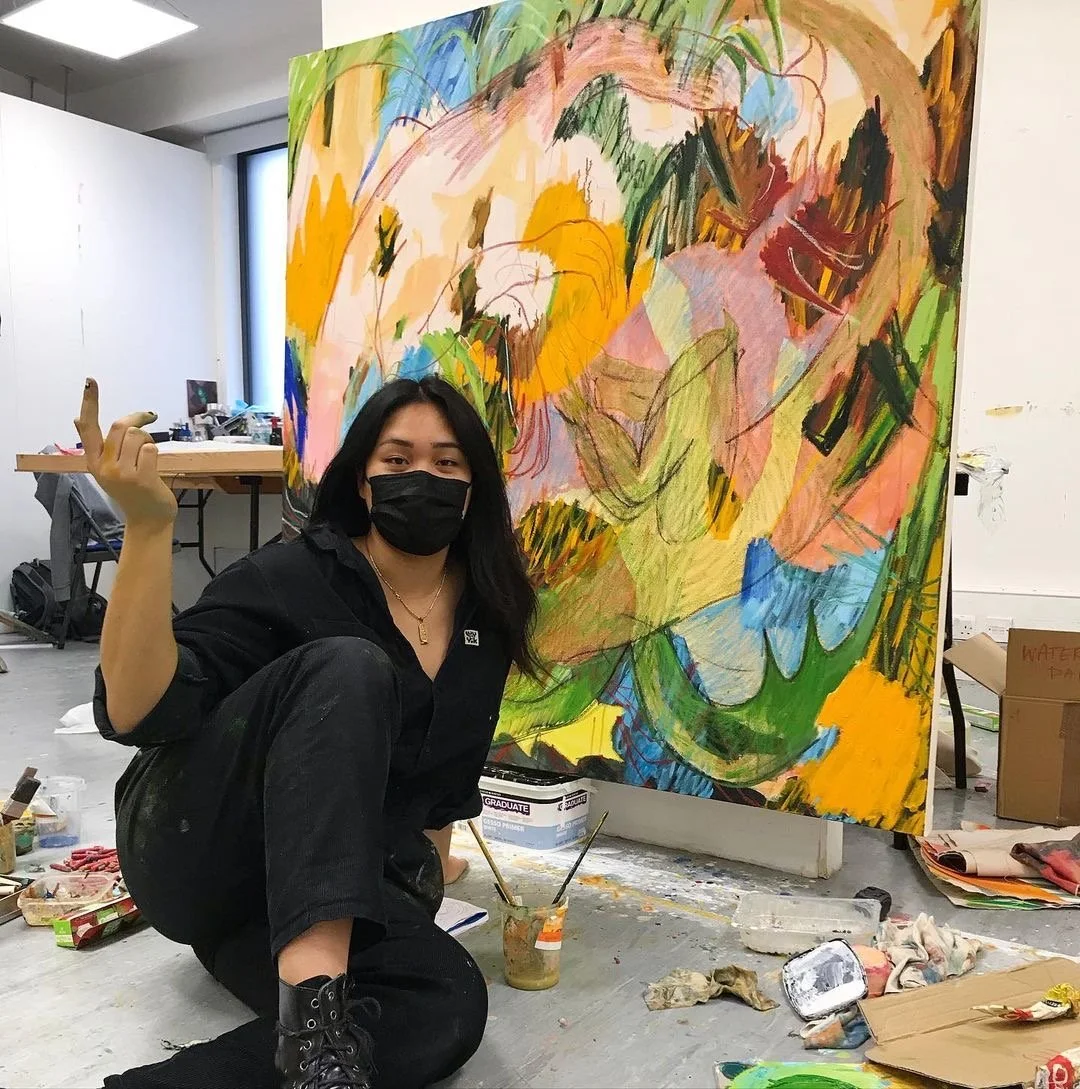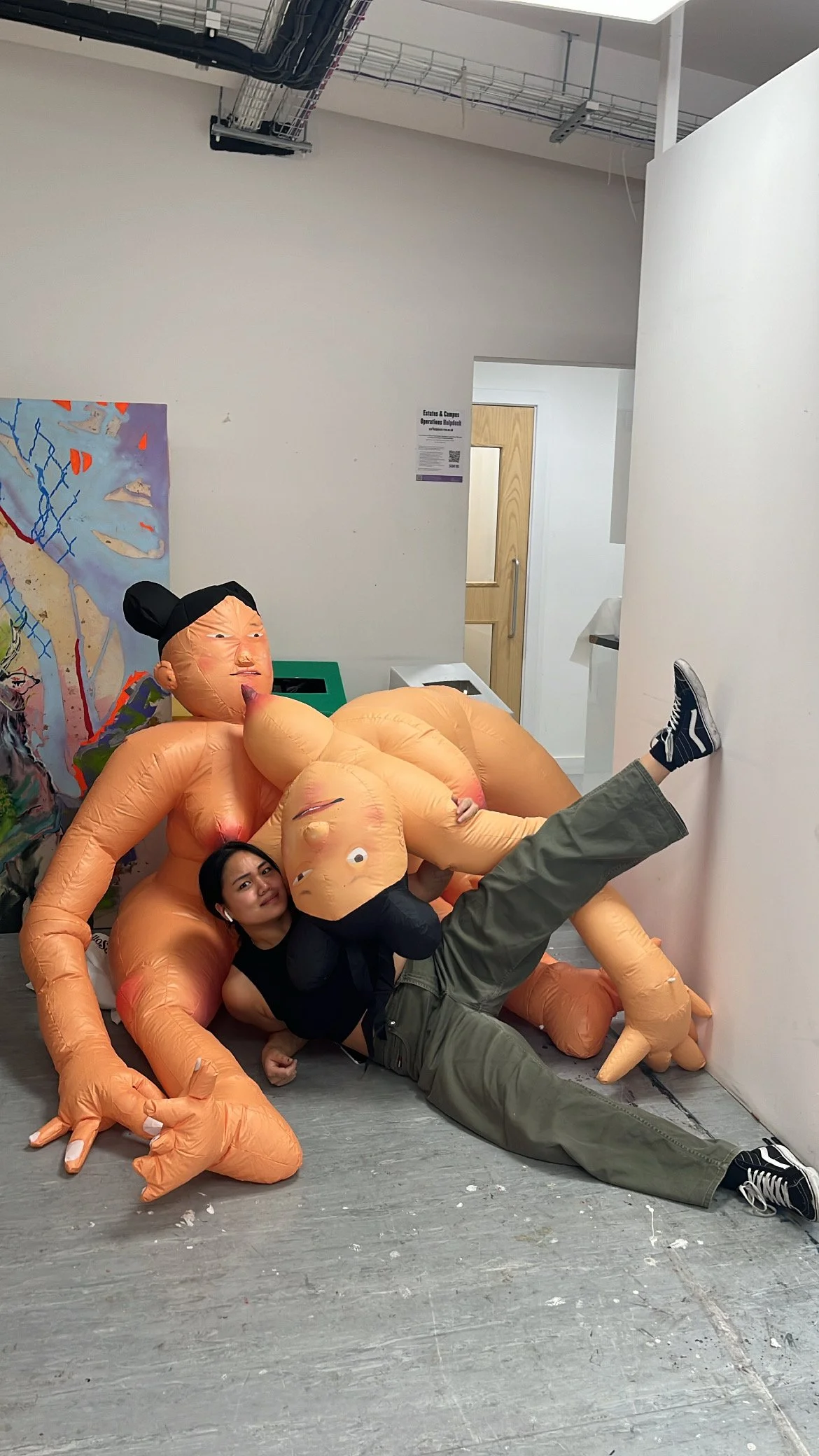Alya Hatta x French Fries
Interview by Margherita Pincioni
Alya Hatta, born in Malaysia, lives and works between London, UK and Kuala Lumpur, MY. She is drawing on personal experiences and memories, Hatta uses the dynamism of colour, form, sound and space to explore the realm of digital and physical in representing her Southeast Asian identity, and to portray the colourful intimacies of the diasporic human condition.
Why did you choose art? A passion from an early age?
It’s hard to define this as a choice, because I think from very young I knew there was only really one way I wanted things to work out for me, and that was going down this artistic journey, of course aided my my parents sending me to colouring classes etc. when I was really tiny. In school, I was always capable and well-rounded in academics, but nothing really struck me as particularly interesting, it was about going through the motions and being an over-achiever. I think that notion of wanting to be ‘the best’ was shortly eliminated after, I guess, the ‘choice’ of moving from Malaysia to the UK going to do my Foundation in Art and Design in Loughborough really opened my mind up about how to think about art, which really reinforced why I love to do what I do.
You paint drawing on your experience and the people around you, how do these interactions inspire your works?
Really I started revolving my work around these personal relationships after I struggled to motivate myself with the handful of essays I had to write in my Undergrad. I always found myself uninspired searching for new things to paint about, or interesting things to write about that I could tie into my work, Google-ing but not really getting anywhere. The only way I managed to move forward was to look inward, and realised that every individual is a rich bank of stories and experiences, and that we are connected to one another. I could draw on myself, my mom, Grandma and discover layers and layers new and shared experiences that I found so inspiring. The distance between me and my family, and my home-town of Kuala Lumpur really highlighted the importance of these connections, and making work about them really strengthens my sense of connection and home.
You were born in Malaysia and live in London, two realities with very different identities. How do you bring them together in your work?
My time in both of these spaces basically form the grounds of my identity culturally. I bring these locations into my work simply, through sourcing materials, patterns, experiences and bringing them together to create a new reality or new world that brings these two places together - mirroring my own self in a way, existing between two realities. For example, I source my materials from Bob’s Bikes down the road but also from digging through my old clothes and pictures from my family home back in Malaysia. Of course, as well, I’m in constant contact with my family who live in London and Kuala Lumpur and bringing together memories or anecdotes are also ways to create new realities for my work. The work is a reflection of my reality just brought into material form through a breadth of sources.
Noor Ida Kahar, your grandmother, was the protagonist of some of your works, can you tell us a personal memory related to her?
One of the most significant memories I’ve had with Nenek (my grandma) is actually quite a mundane one, probably a few years ago, maybe when I was around nineteen/twenty. I just kinda came to the realization that my parents and grandparents have lived a whole life before my existence and I didn’t really know a single aspect except for where people lived, worked etc. Me and None went out for dinner at our local spot near home in Malaysia, and I just started asking her a bunch of things about her personal life, with romance, friends, happiness and sadness. It made me rethink her from this ‘matriarchal enigma’ to being able to relate to as a friend and finding so many things in common with. I think this moment was powerful for me in a way that I really felt connected to our families personal histories.
Your works often contain natural elements. I also know that you have a passion for tropical plants, what is your relationship with Nature?
My passion for tropical plants has one hundred percent stemmed from my mom. Not just all tropical plants but a really specific few, the red lobster claw plant to be specific. I think with moving around so much as a kid, every three years or so, the one consistent thing has been our furniture and our plants. My moms interior design style, very tropical, has been the setting of my life despite having moved over 6 plus times, the same orange, red and green plants around the house set between hand-made Southeast Asian wooden furniture. And so, my relationship with nature is very immediate and specific, I’ll gravitate towards shapes and colours of plants that make me feel a spark and remind me of home.
Instead of the objects? They are often seen literally flying; Are they part of your imagination or are they linked to childhood memories?
These are childhood memories linked and my imagination merges together, as well as still feelings I feel in the present day. I grew up playing a lot of Minecraft, I was so stunned by the beauty of the landscapes during sunrise and sunset and spent time just flying around the world and exploring. The feeling of floating or just zooming around and inspecting the world is a feeling that I seek to this very day. The closest I’ve come to is free swimming in the ocean, amongst the coral reefs, being a weightless explorer. With the objects, it’s a subconscious feeling that ends up being expressed in my work, but yeah, this is something I’ll always continue to chase.
With the dynamism of colour, shape, sound and space you venture into the digital and physical realm: what is the difference between the two worlds?
Personally, there is no difference. You could even refer to the digital works as moving paintings. They are different in construction, yes, but the concept of taking bits and pieces from life and stitching them together in a simulation is the same as putting paints and objects on a canvas. I’m very adamant on not drawing boundaries between genres of art making, everything work comes from the artist and is just an amalgamation of their entire life experience into producing something. When making my digital works I find myself sculpting and painting objects in a digital space that is the same as when I paint on a canvas. Even down to the choice of objects that fly around in my simulations, they’re often the same objects found in my paintings - both methods of working really inspire the other.
In your opinion, today, can the speed of internet culture coexist with generational myths handed down for centuries?
Yes! In fact I think it makes them better. Most of the myths, stories, anecdotes I collect are WhatsApp texts from my Mom or my Grandma. I think that the internet has already integrated itself in our lives too much to detach it from our family culture. Even things like spelling mistakes or pixelated images shared via the internet morphs each myth into a form that isn’t ‘new’ or different but just the reality of now. There’s a convenience and speed of obtaining new information from across the world that I would’ve never been able to experience without the internet. I think that, however, there’s multiple streams of the internet, meme culture, fake news, things that happen on a larger societal scale that I try to stay away from work-wise as it's too hard to relate to or reduce to on a personal level.
Tell us about the inflatable doll project.
The inflatable dolls are an ongoing series of works. I'm planning to make an army of girls, build them up slowly. Originally, the works centred around the idea of play, and the materiality and memories centred around inflatable castles. I wanted to express how the ideas of play shifts from when we are children to when we are adults. And being an asian woman, it’s very hard to deny the levels of fetishisation that we experience in many aspects of our daily lives. The idea was born from this concept but the day I picked the inflatables up, I immediately fell in love with the texture of the materials, how the different body parts look when they’re layered on top of each other, inflating and deflating. I see them as a continuation of my paintings, the characters jumping out the paintings into space.
What is the path to create your digital shorts? They are truly surreal.
The digital works are iterations of a single mechanism that I built some time ago. The more I learn and the more experience I gather, the more I add onto each work. They all stem from an idea of a diary entry, one that is void of time. I like the idea of every part of our days being simultaneously presented to us in a single visual experience. I focus on the things we take for granted, the mundane things that form the bulk of our day and we repeat over and over again. The works are used to highlight the beauty of the everyday, and the excitement we might actually overlook in our daily lives. The majority of my models are made on Blender, some are sourced online, and then everything is put together on the game engine Unity 3D and coded with C sharp. Honestly, a lot of the coding is bootleg and really rusty. I learned how to do everything on YouTube so it’s not the best but I love the randomness brought about by the flaws.
You have lived in Southeast Asia, the Middle East and the UK. The word Diaspora means "abandonment of the native land", what did it mean for you to leave Kuala Lumpur?
Strangely enough, I have an on and off connection with the idea of a ‘native land’, I think my roots are formed by where my family are. So there was definitely a sense of leaving a community, and the sadness of not being able to experience our big family dinners or being close to my parents anymore. Just being taken away from any familiarity is hard. Having spent my time there from year 7 to year 13 and uprooting to a totally different culture is hard. On the other hand, up until I was 11 I moved around a lot with my family, staying places for 2, 3 sometimes less than a year, so it was nothing new, just bitter sweet. I think that with how I grew up, we learn to build our home around the people around us - I’m very thankful of the relationships I’ve built in London, also with my brother living next door, it does feel like I have two homes now.
When you move, are you a tourist or a traveller?
The weight of both these words somehow have an effect on me, they’re both too intentional for me to choose. I think I’m a fly on the wall. Just an observer.
What are you preparing again?
Currently I’m preparing for a duo show at Wilder Gallery happening in mid March and group shows and fairs happening throughout the year, hopefully showing in NYC for the first time. But, most importantly, I’m prepping for my MA Degree show happening in June with the RCA - I’m doing a bunch of research and development now, experimenting with materials etc to really solidify my voice as an image-maker for the show.




